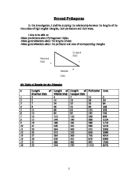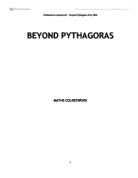(2x3)+1=7
It works for that one, as I can see on my table that with term 3, the side length is 7.
As you can see here:
Length of the middle side: b=2n (n+1)
I now have to test my formula to see if it works
(2x1(1+1))=4
It works for that one, as I can see on my table that with term 1, the middle side length is 4.
(2x2(2+1))=12
It works for that one, as I can see on my table that with term 2, the middle side length is 12.
(2x3(3+1))=24
It works for that one, as I can see on my table that with term 3, the middle side length is 24.
As I can see on my table of results here:
Length of the longest side: c=2n (n+1) +1
(2x1(1+1) +1)=5
It works for that one, as I can see on my table that with term 1, the longest side length is 5.
(2x2(2+1) +1)=13
It works for that one, as I can see on my table that with term 2, the longest side length is 13.
(2x3(3+1) +1)=25
It works for that one, as I can see on my table that with term 3, the longest side length is 25.
As I can see on my table of results here:
I will now check my formulas work when substituted into a Pythagoras’ theorem.
a²+b²=c² is the theorem so ∴ (2n+1) ²+ (2n (n+1)) ² should = (2n (n+1) +1) ²
And now I will substitute my numbers into the formula to check it works. I’m going to do it with the third term:
(2x3 +1) ²+ (2x3 (3+1) ) ² = (2x3 (3+1) +1)²
7²+24²=25²
49+576=625
∴ 625=625, which is correct.
Perimeter: P=a+b+c
Which, once my formulas are substituted in,
becomes:
2+6n+4n2
2+ (6x1) + (4x12)=12
It works for that one, as I can see on my table that with term 1, the perimeter is 12.
4+ (6x2) + (4x22)=30
It works for that one, as I can see on my table that with term 2, the perimeter is 30.
6+ (6x2) + (4x32)=56
It works for that one, as I can see on my table that with term 3, the perimeter is 56.
As I can see clearly on my results table here:
The formula for perimeter works as it is the sum of the formulae for the shortest, middle and longest sides. This will be P=a+b+c and then with my numbers substituted in, it gives you: (2n+1)+(2n(n+1))+(2n(n+1)+1)
Then, once it is simplified, it gives you: 2+6n+4n2 .
The reason I did that to work out my perimeter is because the perimeter is the length around the outside of the shape, so it is therefore the sum of the lengths of all its sides.
Area: A=0.5xBasexHeight
or A=½(ab).
(4n3 + 6n2 +2n)/2 or 0.5(4n3 + 6n2 +2n)
And I will now test it to see if my formula is correct:
((4x13) + (6x12) + (2x1))/2=6
It works for that one, as I can see on my table that with term 1, the area is 6.
((4x23) + (6x22) + (2x2))/2=30
It works for that one, as I can see on my table that with term 1, the area is 30.
((4x33) + (6x32) + (2x3))/2=84
It works for that one, as I can see on my table that with term 1, the area is 84.
As is seen on my results table here:
The reason that the area formula is what it is is due to the fact that the usual formula for working out the area of a triangle is: 0.5bh. As we can work out that the shortest and middle sides and the base and the height, we can apply that formula.
It will therefore be:
(2n+1)x(2n(n+1))
2
Then, once that formula is simplified, you have the formula for the area:
4n3 + 6n2 +2n
2
My formulas mean I can find out the side lengths, area and perimeter of any triangle when given the term (nth) number.
To check that all my formulas are correct, I am going to check them all on a real triangle. This time I shall be using the 4th terms, as I didn’t test them before:
The reason the a²+b²=c² formula works for all right angled triangles is that the length squared of the two smaller sides, when added together, equals the length of the hypotenuse (the longest side).
c
In my diagram, a+b=c
As you can see, the area of the square on the hypotenuse has the same area as the total of the areas of the squares on the adjacent sides. This means that it will also work the same when you square the lengths of the sides, which is why his theorem works.
I have seen from my investigation that when I have a term number, I can find out a whole range of properties of one triangle from it. I can not only find out all the three side lengths, but can also find out other information such as its perimeter and its area. The formulas I found out are very useful, as they work for all the triangles I’ve tested and therefore I assume that they work for most, if not all, right angled triangles. Henceforth I know that I can use them for numbers above zero up to infinity, one would assume.
However, as I haven’t actually tried my formulae with numbers ending in .5, I cannot be sure if they will work for that. Therefore, I am now going to look at if the formulae I worked out are still valid when they are not whole numbers. If I use .5 numbers, I assume that all my shortest side lengths will now be even numbers compared to odd which they were before. This could change the way the formulas work, so I will need to check them all to be sure. I am not going to try any number which is a negative though, because this would not be a possible figure in terms of shape and measure, as the triangle would not exist.
I’m going to try with n=1.5 first. If this does not work, then I will try and come up with a new formula. If it does work, I will have to test it with other .5 terms to make sure my results are reliable as otherwise it could just be only that .5 term it works for. I will use Pythagoras’ theorem to test it .If it does work, then when I substitute the numbers in, the final results will be correct, with the same number on both sides of the equals sign. If it’s not, then the formula isn’t working and I need to work out one which does.
a²+b²=c² is the theorem ∴ (2n+1) ²+ (2n (n+1)) ² = (2n (n+1) +1) ²
(2x1.5+1) ²+(2*1.5(1.5+1)) ²=(2x1.5(1.5+1)+1) ²
4²+7.5²=8.5²
16+56.25=72.25
Therefore
72.25=72.25 which is correct, which therefore means my formula so far works for the length of the shortest side. Now I am going to try it with another to see if I get the same result.
(2x2.5+1) ²+(2*2.5(2.5+1)) ²=(2x2.5(2.5+1)+1) ²
6²+17.5² =18.5²
36+306.25=342.25
Therefore
342.25=342.25 which is correct, as the two numbers must be the same as a number cannot possibly equal a different number.
I am now going to test it with one more example, to be sure that it is reliable.
(2x3.5+1) ²+(2*3.5(3.5+1)) ²=(2x3.5(3.5+1)+1) ²
8²+31.5²=32.5²
64+992.25=1056.25
Therefore
1056.25=1056.25 which is again correct as an equation must equal the same on both sides.
I think these tests have proved that my formulae for all of the lengths of the triangles are correct, because in all three examples, the answers came out exactly right, down to the decimals. If there was any indiscretion, one would assume that it would have shown up in at least one of these three examples.
I will now test my area and perimeter formulas to see if they also still work with decimal numbers. I would assume that this too would work with decimal numbers, but I think I should check because I cannot be sure until I have done so.
The formula I’m using is 2+6n+4n2, where I’m going to be substituting numbers in for n.
Test One: 2n+6n+4n2=
2+6x1.5+4x1.52=
3+9+9=
20
And I will now work out what the perimeter should be, without using a formula and instead adding the numbers I found out for the side lengths in my previous tests, and see if they are the same.
7.5+8.5+4=20
This also equals 20, so I know that my formula has worked for it too.
I will try one more time to make it reliable.
Test Two: 2n+6n+4n2=
2+6x2.5+4x2.52=
2+15+25=42
I will now do the same as I did before, and work out the perimeter myself by adding the lengths I found out before to see if the answer is the same as the one I got via my formula.
6+17.5+18.5=42
This also equals 42, which means my formula is also correct with decimal numbers, and numbers where the shortest side is even instead of odd.
I am now going to do the same for the area. The formula for the area is
4n3 + 6n2 +2n
2
And I will substitute in my numbers like I did before, and then test it with a worked out answer to see if they are the same.
Test one: (4n3 + 6n2 +2n)/2=
(4x1.53 + 6x1.52 +2x1.5)/2=
(13.5+13.5+3)/2=
30/2=
15
And now I will work out what the area should be, using the correct lengths worked out before:
A=0.5bh
A=0.5x4x7.5
A=15
The area does equal 15, which means my formula worked correctly. I will test it one more time to be sure though.
Test two: (4n3 + 6n2 +2n)/2=
(4x2.53 + 6x2.52 +2x2.5)/2=
(62.5+37.5+5)/2=52.5
And now I will again work out what the area should be, so as to see whether my formula works in this situation or not.
A=0.5bh
A=0.5x6x17.5
A=52.5
The area does equal 52.5, which proves that my formula did work correctly, and so does work correctly for whole numbers and decimals, and therefore also works correctly for triangles with an even shortest length side along with ones with an odd shortest length.
From my investigation, I have discovered many things. I have looked in depth into Pythagoras’ theorem and seen why it works, which has broadened my understanding of the idea. I have also worked out a formula for the three key things that you need to know about a triangle: side lengths, perimeter and area. These can all be worked out successfully by using only the term number.
I am pleased to have learnt that my formulae aren’t only limited to working with whole positive numbers, and can work with decimals too. This makes it far more useful than it would have been for just whole numbers. It is good to know that it is versatile as that makes it more usable. If I were to expand and develop my investigation further, I think I might have tried to find out what would happen f I doubled the size of the triangles, and then tried to work out formulas from them. I would be curious to know whether the same formula would also work for them, or whether a new one would need to be developed. I would also have maybe tried to find a working formula for triangles which are not right angled, as my formula is only limited to ones with a right angle. It would be a lot harder, but if I were to do this investigation, I would try to do that. If I were to re-do my investigation completely, I think I would try to include more testing, especially for the last ones, and include more results for the lengths, perimeters and areas than just going up to the 16th term. I think maybe going up to at least 30 could have been more beneficial.







